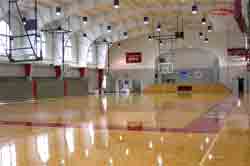Gymnasium Lighting |
|
|
With few exceptions, metal halide high bay and low bay lights are the best luminaires to use for gymnasium lighting. They are common in school gyms, clubs, and recreational basketball courts and provide a robust source of white light with a high CRI. In smaller gyms where color rendering is not as important and budget is limited, high pressure sodium fixtures can be substituted. Because standard ceiling height for most gymnasiums measures around 25’, the optimal mounting height for HID lights is 22’ above the gym floor. To protect the fixtures against accidental ball impacts, it is recommended to use die cast aluminum fixtures suspended on hooks or safety chains to allow the fixture to swing with the impact if hit during a game.
In some smaller gyms ceilings where ceilings are exceptionally low, and players and spectators have limited space. Use enclosed gasketed low bays in these areas to keep lighting levels even but comfortable and glare free. When lighting gymnasiums in areas with high dust content in the atmosphere, it is generally advisable to use industrial high bay light fixtures that are made with enclosed optics. In some cases, you might want to consider installing twin-mounted gymnasium lights for better light distribution and better lighting control. Pulse start metal halides are the best fixtures to use in any of these scenarios because of their quick restrike time and significantly faster warm up time. They also offer a competitive advantage over automatically switched quartz instant on lighting because they require no modification or customize components to perform these tasks.
The most common ballasts used in gymnasium lighting are standard auto regulator CWA. These provide good energy efficient, reliable power distribution for most HID fixtures used in gym lighting. Other ballast types may be needed, however, if other luminaires are substituted for those generally installed. Remote ballasting is recommended if at all possible to protect equipment from accidental ball impact. Once again, these mitigating problematics are much easier to tackle with a detailed photometric report on the gymnasium and its lighting and reflectivity dynamics. The cost of the report is refunded to paying clients at the time of equipment purchase, and drop shipping to client site and adjunct advisory lighting design services are standard procedures for RLLD Commercial Lighting.
RLLD Commercial Lighting carries a wide variety of industrial & commercial lighting fixtures. If you can not find what you are looking for call us toll free at 1-866-654-3961 and we will find it for you. Our home office is located in Houston, Texas with warehouses located throughout the United States that enable us to service all 50 states including like Ft. Lauderdale, FL (FLL), Orlando, Florida (MCO), Santa Monica, CA, (LAX) Columbus, Ohio (CMH) (LGA) New York, NY, (JKF), St. Louis, MO, Detroit, Michigan (DTW), Madison, WI (MSN), San Francisco, California (SFO), and Omaha, Nebraska (OMA) Regional Commercial Lighting Locations |
|
Back to main topic: Athletic & Sports Field Lighting
|
|
| Contact Us |
|
|
| Products |
| Articles |
|
| Information |
|
 Gymnasium Lighting
Gymnasium Lighting RLLD Commercial Lighting recommends using 400 watt metal halide fixtures for gymnasium lighting.
RLLD Commercial Lighting recommends using 400 watt metal halide fixtures for gymnasium lighting. This is another reason why we discourage the use of 1000watt fixtures as gymnasium lights.
This is another reason why we discourage the use of 1000watt fixtures as gymnasium lights.